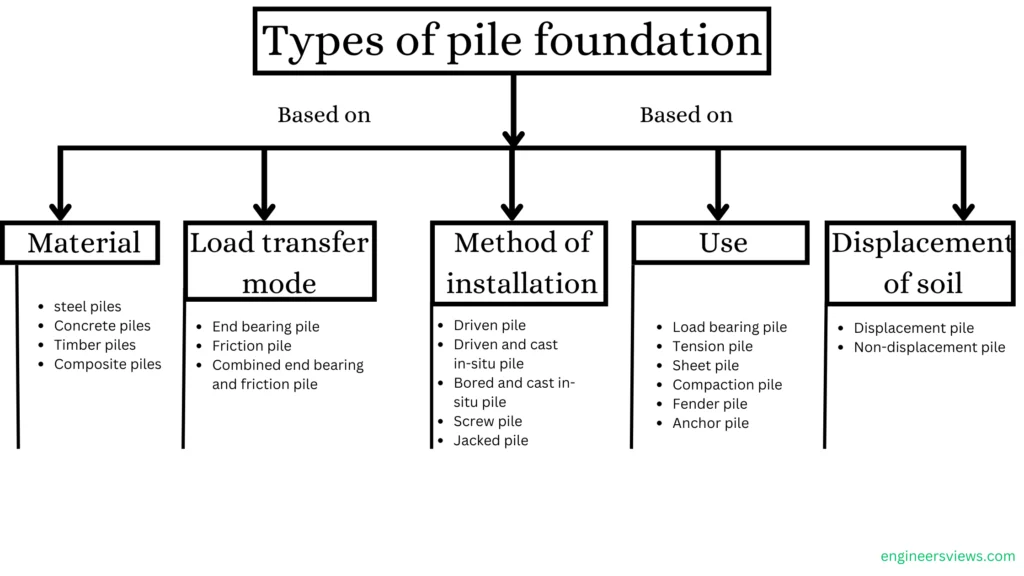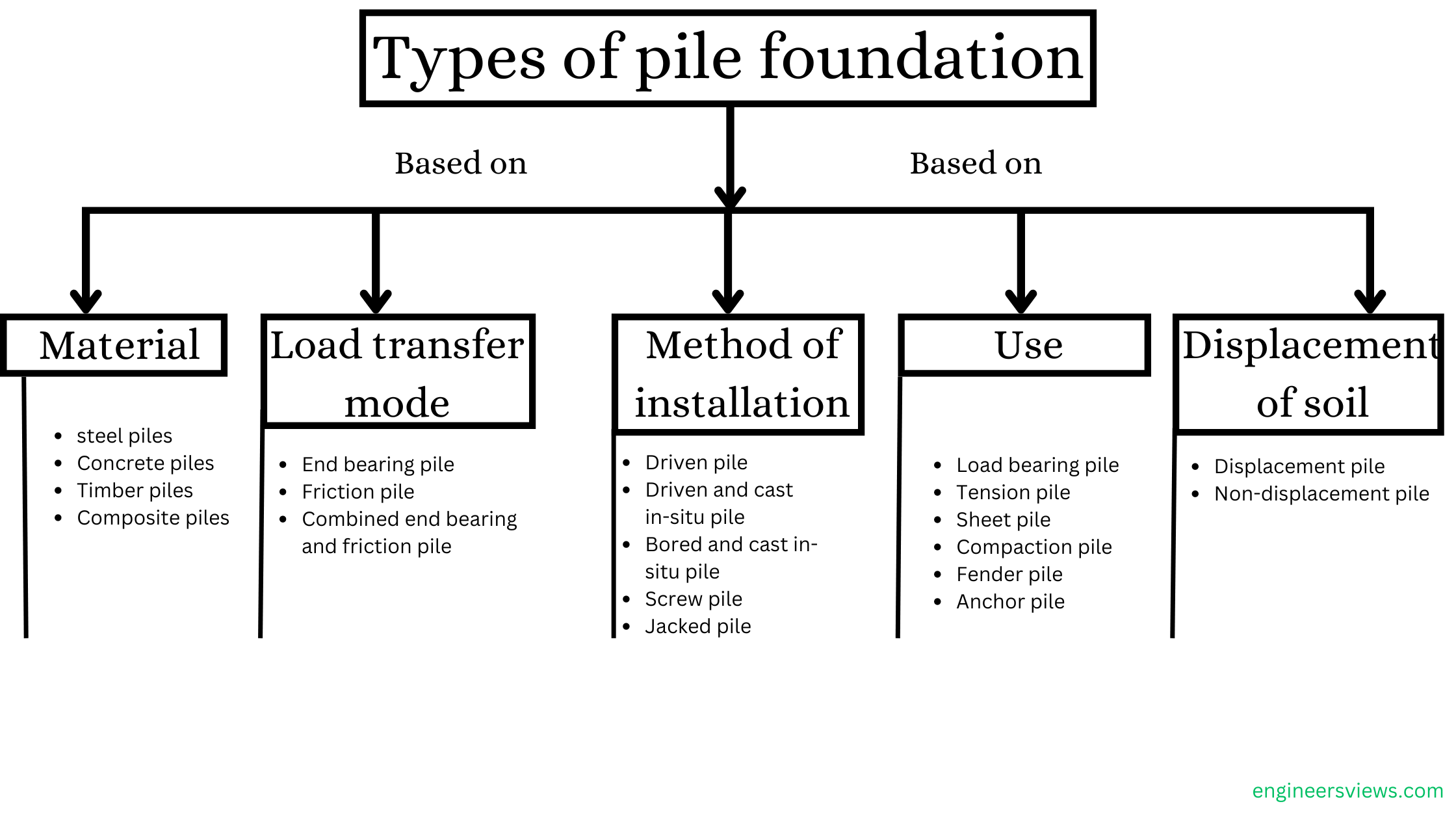Pile foundation is a type of deep foundation which is generally a slender structural member made from concrete, timber or wood and it transfers the load from superstructure to the ground soil by different mechanisms . Pile foundations are constructed either by driving a precast pile into the ground or casting a pile in the site where foundation trench is already excavated. Pile foundations are used as ultimate type of foundations where other types of foundation are not suitable of feasible.
pile foundation is a deep foundation because it is a slender member so its depth is very much larger than it’s width or diameter. Pile foundations are generally used when the soil strata near the ground surface is very loose or there exists ground water table and it is also preferred when a hard rock strata exists at some depth ( not very large )below ground surface even if the soil strata is reasonably stiff and hard.
Necessity of pile foundation
Pile foundations are used or required in the following circumstances:
- When the soil strata very near to ground surface is very weak, compressible and saturated so that it can not support the load from the structure.]
- When Ground water table (GWT) exists very near to ground surface.
- Pile foundations are also preferred in those places where there is high probability of occurrence of lateral load like earthquake load, wind load etc. because pile foundations have large depth so that they can resist large horizontal load when they are properly jointed to super structure.
- When there is high possibility of differential settlement in foundation soil ( due to eccentric loading, variation in soil properties etc) , shallow foundation are not reliable. In this condition pile foundations are constructed.
- Pile foundations are also used in those structures which are subjected to uplift . For example : Siphon Aqueduct, transmission towers etc.
Types of Pile Foundation
Piles foundation can be classified on different basis as explained below.
- On the basis of material used
- Based on the load transfer mechanism
- Based on the method of construction/installation of piles
- Based on the use of Pile
- On the basis of displacement of soil below or on the surface of pile.

Classification of Pile foundations based on the Material used
1. Steel Piles
- Made from steel and generally are in rolled H-sections or thick hollow pipe sections. Hollow cylindrical section is commonly used.
- Generally hollow steel tubes are driven into the ground with their ends open or closed.
- Steel piles have to be protected from corrosion. For this some type coatings have to be applied on the pile surface . In some cases, to take into account the effect of corrosion piles are provided with some additional thickness of steel.
- In most of the cases , Steel piles can be driven up to depth of 24m and they can withstand load up to 100 tons.
2. Concrete Piles
- Pre-cast or cast in-situ cement concrete piles are provided.
- Precast concrete piles are driven into the ground by applying stress so it has to be constructed by providing sufficient reinforcement to sustain the stress during its handling and installation.
- Cast in situ concrete piles are casted in the field by making hole in required location and then filling it by concrete. Cast in situ pile may be cased or uncased.
- Generally Concrete piles can be constructed up to depth of 27m and they can bear load up to 100 tons.
3.Timber Piles
- Made from tree trunks which should be straight and free from defects.
- A metal cap or band is provided on top to prevent the pile from damage during installation.
- Generally pile foundations below ground water table have long life than piles in soil because insects attacks are high in soil than in water.
- Commonly , Timber piles can be driven up to depth of 20m and they can carry load up to 60tons.
4. Composite Piles
A Composite pile is made from combination of two or more material. A composite pile can be constructed by providing lower steel portion and upper cast in situ concrete portion or lower timber portion and upper cast in situ concrete portion.
Composite piles are rarely used because it is very difficult to provide proper joint between two different materials and it becomes more difficult because the joint has to be provided at certain depth below the ground surface.
Classification of Pile foundations on the basis of Mode of load transfer mechanism
Based on the mode of load transfer from pile into the surrounding soil , pile foundations are classified into the following three types.

1. End Bearing Piles
End bearing pile transfer the load from structure to the surrounding soil through its bottom tips. End bearing piles are used when a hard rock or firm soil strata exists at reasonable depth from the ground surface. End bearing piles are also known as point-bearing piles.
The ultimate load carrying capacity of end bearing pile is equal to maximum load that can be transferred through the bottom of pile . Larger the bottom area of, pile larger will be the load carrying capacity of pile.
2. Friction Pile
Friction pile transfer the load from structure to the surrounding soil by means of skin friction between soil and surface of pile. Friction pile are used when there is no hard rock or firm soil strata available at reasonable depth below ground level. Friction piles are also known as floating pile because they do not reach to the depth of hard rock, thus look like floating above rock strata.
Ultimate load carrying capacity of friction pile is equal to the load transferred through skin friction between soil and pile surface which ultimately depends on the degree of adhesion between soil and pile surface.
3. Combined End bearing and friction piles
These type of pile transfer load from structure to the ground soil by both end bearing at bottom of pile and through skin friction methods.
Load carrying capacity of these piles is equal to the sum of end point load transfer and load transferred through skin.
Classification of Pile foundations based on Method of construction / installation of piles
There are several methods of installation or construction of piles on the site . Based on these methods, Pile foundations are mainly classified into the following types:
1. Driven piles
This type of pile are driven into the ground by hammering on the top .Heavy blows of hammer are applied on the top of pile to drive it to required depth.
2. Driven and cast in-situ piles
In this type of pile , the word driven means driving the casing of closed bottom to required depth into the soil and cast in situ means filling this casing with concrete . The casing may or may not be removed from the ground.
3. Bored and cast in situ piles
These types of pile are casted in the site by boring a hole and then filling it with cement concrete.
4. Screw Piles
Screw piles are installed at required location by screwing it into the ground ( i.e. by applying rotational force ).
5. Jacked piles
Jacked piles are prefabricated piles and are installed in the ground by application of hydraulic jack.
Classification of piles based on use
1. Load Bearing Pile
As the name suggests, load bearing piles are used to transfer the load safely from structure to ground by point bearing or skin friction or by both mechanism. These types of piles are mostly used.
2. Tension Piles
These piles are mainly used to carry tension force or anchor any structures which are subjected to hydrostatic uplift or overturning forces.
3. Sheet piles
Sheet piles are thin sheet which is used to carry earth mainly during excavation.
4. Compaction Piles
These piles are used to increase the density of loose granular soil by driving the pile.
5. Fender Piles
These piles are a type of sheet piles which are used to protect structures in water from impact of ships and other moving objects.
6. Anchor piles
Anchor piles are used to support sheet piles . Anchor piles are inserted in horizontal direction or slightly inclined with horizontal and the carry the load from sheet pile and transfer it to the surrounding soil mainly by means of skin friction.
Classification of pile based on displacement of soil
1. Displacement piles
All types of driven piles fall into this category because soil is displaced during their installation and soil gets densified due to lateral compression acting on soil. Pre cast concrete piles and closed bottom pile belong to this category.
2. Non-displacement piles
If there is no disturbance or densification of soil during installation of pile , these piles are non-displacement pile. As the soil is removed first and pile is installed , no disturbance occurs in surrounding soil.
